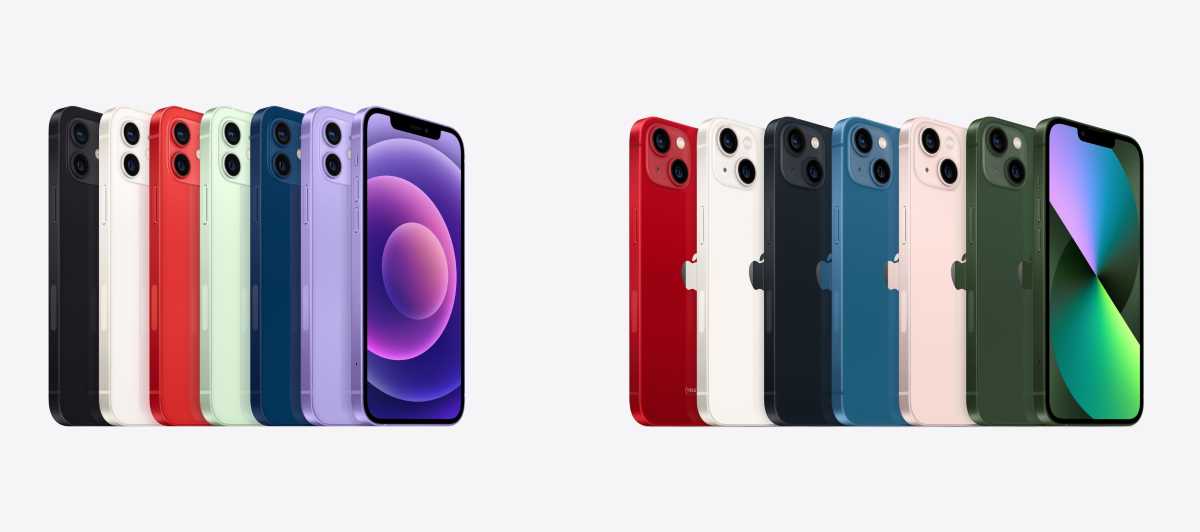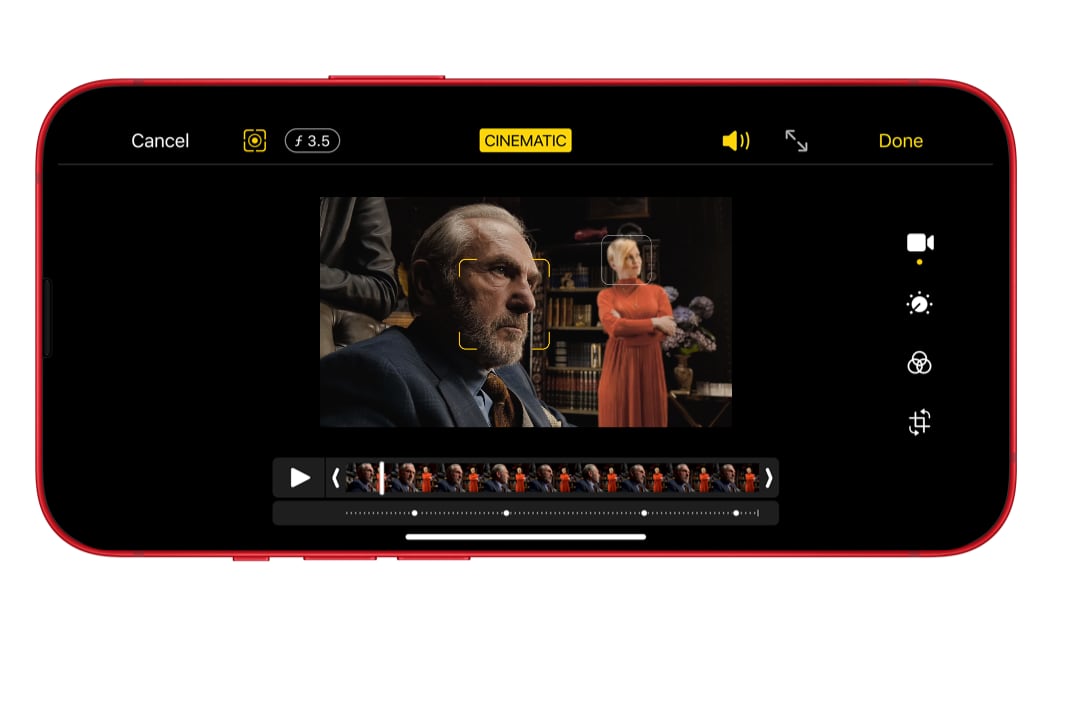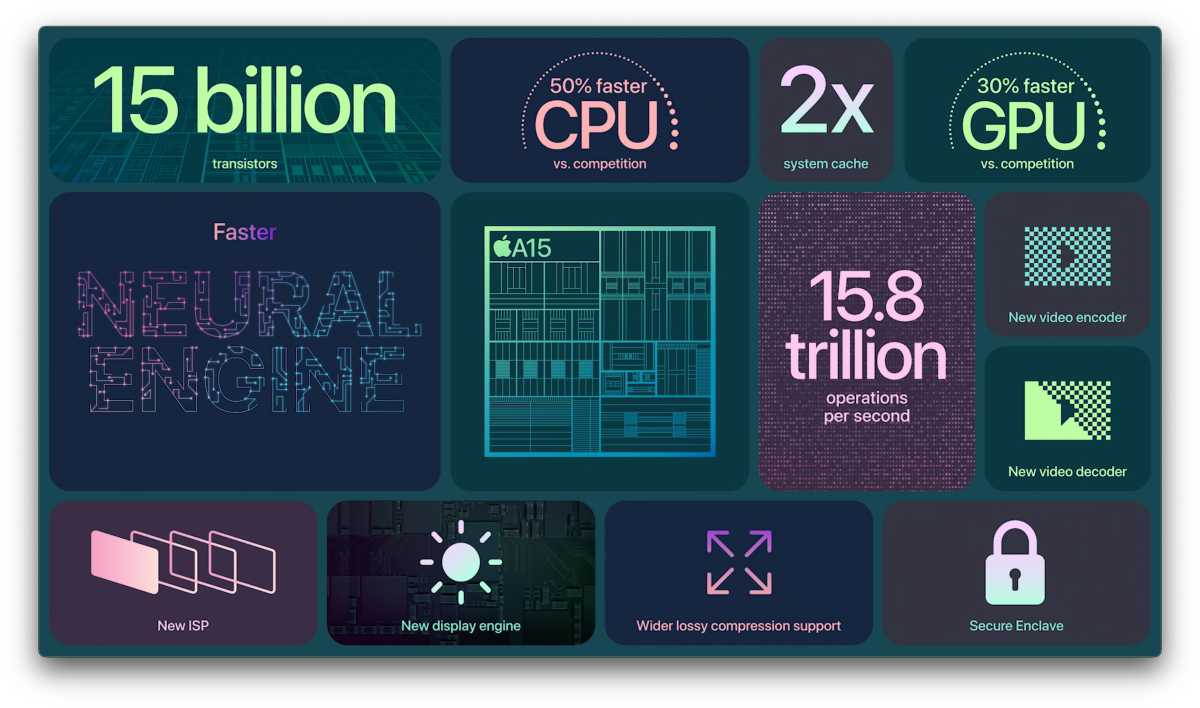Not everyone can afford the latest iPhones from Apple, especially with prices that approach or surpass $1,000. The truth is, most people don’t need the latest models, and Apple has attractive prices on older ones. For example, Apple still sells the iPhone 12 and the iPhone 13 mini, and both of those phones have a starting price of $599, which is a lot more friendly to your pocketbook.
Let’s take a look at the major components of the iPhone 12 and iPhone 13 and how they compare to help you decide on which model to buy.
iPhone 12 vs iPhone 13 mini: Specs
| iPhone 12 | iPhone 13 mini | |
|---|---|---|
| Display | 6.1 inch Super Retina XDR OLED 2532×1170-pixel resolution at 460 ppi | 5.4 inch Super Retina XDR OLED 2340×1080-pixel resolution at 476 ppi |
| Dimensions | 5.78 in x 2.82 in x 0.29 in | 5.18 in x 2.53 in x 0.30 in |
| Weight | 5.78 oz | 4.97 oz |
| Colors | Black, Blue, Green, Product(RED), Purple, White | Blue, Green, Midnight, Pink, Product(RED), Starlight |
| Processor | A14 Bionic | A15 Bionic |
| Storage | 64GB/128GB/256GB | 128GB/256GB/512GB |
| Rear Camera | Dual 12MP Wide: ƒ/1.6 aperture Ultra Wide: ƒ/2.4 aperture Optical image stabilization Smart HDR 3 for photos | Dual 12MP Wide: ƒ/1.6 aperture Ultra Wide: ƒ/2.4 aperture Sensor-shift optical image stabilization Smart HDR 4 for photos |
| Front Camera | 12MP TrueDepth f/2.2 aperture Smart HDR 3 for photos | 12MP TrueDepth f/2.2 aperture Cinematic mode for videos Smart HDR 4 for photos |
| Video Recording | 4K video recording at 24 fps, 30 fps or 60 fps HDR Dolby Vision up to 30fps | 4K video recording at 24 fps, 30 fps or 60 fps HDR Dolby Vision up to 60fps Cinematic Mode |
| Biometric Security | Face ID | Face ID |
| Connectivity | Wi-Fi 6 5G LTE Bluetooth 5.0 Lightning | Wi-Fi 6 5G LTE Bluetooth 5.0 Lightning |
| Wireless Charging | MagSafe, Qi | MagSafe, Qi |
| Waterproofing | IP68 | IP68 |
| SIM | Dual SIM (nano and eSim) | Dual SIM (nano and eSim) Dual eSIM |
| Battery Life | 17 hours video playback | 13 hours video playback |
| Price | $599/$649/$749 | $599/$699/$899 |
iPhone 12 vs iPhone 13: Design and colors
The iPhone 12 and iPhone 13 mini feature the same flat-edge design, but the mini is smaller and lighter. The two lenses on the rear camera bump are vertical on the iPhone 12. On the iPhone 13 mini, they’re diagonal.
The color offerings are different. Even three colors that have the same name on both models—blue, green, and Product(RED)—are different shades.
 https://b2c-contenthub.com/wp-content/uploads/2023/02/iPhone-12-13-mini-colors.jpg?resize=300%2C133&quality=50&strip=all 300w, https://b2c-contenthub.com/wp-content/uploads/2023/02/iPhone-12-13-mini-colors.jpg?resize=768%2C340&quality=50&strip=all 768w, https://b2c-contenthub.com/wp-content/uploads/2023/02/iPhone-12-13-mini-colors.jpg?resize=1200%2C532&quality=50&strip=all 1200w, https://b2c-contenthub.com/wp-content/uploads/2023/02/iPhone-12-13-mini-colors.jpg?resize=1536%2C681&quality=50&strip=all 1536w, https://b2c-contenthub.com/wp-content/uploads/2023/02/iPhone-12-13-mini-colors.jpg?resize=2048%2C908&quality=50&strip=all 2048w" width="1200" height="532" sizes="(max-width: 1200px) 100vw, 1200px" />
https://b2c-contenthub.com/wp-content/uploads/2023/02/iPhone-12-13-mini-colors.jpg?resize=300%2C133&quality=50&strip=all 300w, https://b2c-contenthub.com/wp-content/uploads/2023/02/iPhone-12-13-mini-colors.jpg?resize=768%2C340&quality=50&strip=all 768w, https://b2c-contenthub.com/wp-content/uploads/2023/02/iPhone-12-13-mini-colors.jpg?resize=1200%2C532&quality=50&strip=all 1200w, https://b2c-contenthub.com/wp-content/uploads/2023/02/iPhone-12-13-mini-colors.jpg?resize=1536%2C681&quality=50&strip=all 1536w, https://b2c-contenthub.com/wp-content/uploads/2023/02/iPhone-12-13-mini-colors.jpg?resize=2048%2C908&quality=50&strip=all 2048w" width="1200" height="532" sizes="(max-width: 1200px) 100vw, 1200px" />Both the iPhone 12 (left) and iPhone 13 mini are available in 6 colors.
Apple
Our pick: The design differences aren’t much to sway you one way or another. The lens placement is a non-issue, the extra weight on the iPhone 12 isn’t enough to influence a decision. It’s really a matter of size and what color you prefer–the color palettes for each phone are different. But if you put a case on the iPhone, you may not care about the phone’s color.
iPhone 12 vs iPhone 13 mini: Display
Both the iPhone 12 and iPhone 13 mini have a Super Retina XDR display, a 2,000,000:1 contrast ratio, True Tone, and P3 color support. One difference is that the iPhone 13 mini is 28 percent brighter, with a typical max brightness of 800 nits, while the iPhone 12 is rated at 625 nits. Both phones have an HDR maximum brightness of 1,200 nits.
Our take: If you are often in a situation where you have difficulty seeing the screen in an environment with bright lights, consider the iPhone 13. Even though it’s smaller than the iPhone 12, its brighter screen will be easier to see in those situations, but the iPhone 12’s screen is still more than adequate for everyday use.
iPhone 12 vs iPhone 13 mini: Cameras
Here is where the iPhone 13 has a few differences that could sway your decision. Users who take their photos and videos very seriously could be persuaded by the new camera features.
The reason the iPhone 13 mini’s rear camera lenses are now diagonal is so that Apple can fit a sensor-shift optical image stabilization system in there. It improves upon the standard optical image stabilization that is in the iPhone 12. The main specs for the rear camera on the two phones are the same—12MP Wide (ƒ/1.6 aperture) and Ultra Wide (ƒ/2.4 aperture)—but the main camera has a larger sensor for better low-light performance. The front cameras have the same specs (12MP, ƒ/2.2 aperture), but the iPhone 13 mini’s selfie cam has support for the newer features than the 12.
The iPhone 13 mini now features what Apple calls Photographic Styles, which can change color tones without affecting skin tones. You can apply a style called Rich Contrast, and the shadows in a photo darken and colors become deeper. The Vibrant style makes photos brighter, while the Warm style increases golden tones, and the Cool style emphasizes blue colors.
A key new video feature is Cinematic mode, which creates a shallow depth of field—the person remains in focus while the background is blurred. You can shift the focus from one person to another, and you can even edit the effect on the iPhone to adjust the blur or change the focus. Cinematic mode works at 1080p at 30 fps.
 https://b2c-contenthub.com/wp-content/uploads/2021/09/iphone-13-cinematic-mode.jpg?resize=300%2C200&quality=50&strip=all 300w, https://b2c-contenthub.com/wp-content/uploads/2021/09/iphone-13-cinematic-mode.jpg?resize=768%2C512&quality=50&strip=all 768w, https://b2c-contenthub.com/wp-content/uploads/2021/09/iphone-13-cinematic-mode.jpg?resize=150%2C100&quality=50&strip=all 150w" width="1024" height="682" sizes="(max-width: 1024px) 100vw, 1024px" />
https://b2c-contenthub.com/wp-content/uploads/2021/09/iphone-13-cinematic-mode.jpg?resize=300%2C200&quality=50&strip=all 300w, https://b2c-contenthub.com/wp-content/uploads/2021/09/iphone-13-cinematic-mode.jpg?resize=768%2C512&quality=50&strip=all 768w, https://b2c-contenthub.com/wp-content/uploads/2021/09/iphone-13-cinematic-mode.jpg?resize=150%2C100&quality=50&strip=all 150w" width="1024" height="682" sizes="(max-width: 1024px) 100vw, 1024px" />Apple
Our pick: For users who make the cameras the top priority, the iPhone 13 mini is the way to go. The cameras are better and the new features are great for content creators who want to do more with their photos and videos. However, if your use case is more about snapshots and short video clips, you’ll find a great camera in the iPhone 12.
iPhone 12 vs iPhone 13 mini: Battery life
Since the iPhone 13 mini is smaller than the iPhone 12, it has a smaller battery. According to information provided by Apple to Chemtrec, the iPhone 13 mini’s battery is listed with a capacity of 9.34 watt hours, compared to the iPhone 12’s 10.78Wh, a 15 percent increase. However, Apple’s specifications state that both the iPhone 12 and the iPhone 13 mini offer 17 hours of video playback. But the iPhone 13 mini has a 13-hour rating for streamed video, which is 2 hours longer than the iPhone 12. The iPhone 12 offers 65 hours of audio playback (10 hours more). In our testing, the iPhone 12 lasted roughly eight and a half hours, about two hours longer than the iPhone 13 mini.
Both iPhones are compatible with MagSafe and Qi wireless charging. If you use a 20W or higher charger, both phones can add up to a 50 percent charge in 30 minutes.
Our pick: Either phone is quite capable of getting you through a day and more. If you make frequent use of the phone as a tool for work or your personal projects, the bigger battery in the iPhone 12 is more reassuring.
iPhone 12 vs iPhone 13 mini: Processor
Apple did an interesting thing when it talked about the iPhone 13 mini’s processor: it compared the new A15 Bionic’s performance to “the competition” instead of the iPhone 12’s A14 Bionic. The is probably because it can make greater claims against the competition, while comparisons to the A14 Bionic may not be as significant in Apple’s view. We’ve done our own testing of the A15 chip in the iPhone 13 and it shows a modest 11 percent boost over the A14 Bionic in the iPhone 12.
The A15 Bionic, like the A14 Bionic it replaces, has 6 CPU cores (2 performance cores and 4 efficiency cores), a 4-core GPU, and a 16-core Neural Engine. That’s one less GPU core than in the iPhone 13 Pro, but shouldn’t make much of a difference in anything other than high-end games and apps.
 https://b2c-contenthub.com/wp-content/uploads/2021/09/apple-A15-chip.jpg?resize=300%2C177&quality=50&strip=all 300w, https://b2c-contenthub.com/wp-content/uploads/2021/09/apple-A15-chip.jpg?resize=768%2C454&quality=50&strip=all 768w, https://b2c-contenthub.com/wp-content/uploads/2021/09/apple-A15-chip.jpg?resize=1200%2C709&quality=50&strip=all 1200w, https://b2c-contenthub.com/wp-content/uploads/2021/09/apple-A15-chip.jpg?resize=1536%2C907&quality=50&strip=all 1536w, https://b2c-contenthub.com/wp-content/uploads/2021/09/apple-A15-chip.jpg?resize=2048%2C1209&quality=50&strip=all 2048w" width="1200" height="709" sizes="(max-width: 1200px) 100vw, 1200px" />
https://b2c-contenthub.com/wp-content/uploads/2021/09/apple-A15-chip.jpg?resize=300%2C177&quality=50&strip=all 300w, https://b2c-contenthub.com/wp-content/uploads/2021/09/apple-A15-chip.jpg?resize=768%2C454&quality=50&strip=all 768w, https://b2c-contenthub.com/wp-content/uploads/2021/09/apple-A15-chip.jpg?resize=1200%2C709&quality=50&strip=all 1200w, https://b2c-contenthub.com/wp-content/uploads/2021/09/apple-A15-chip.jpg?resize=1536%2C907&quality=50&strip=all 1536w, https://b2c-contenthub.com/wp-content/uploads/2021/09/apple-A15-chip.jpg?resize=2048%2C1209&quality=50&strip=all 2048w" width="1200" height="709" sizes="(max-width: 1200px) 100vw, 1200px" />The iPhone 13’s A15 Bionic offers a good boost over its predecessor, but you may not notice a difference if you already have an iPhone 12.
Apple
Our pick: While the geeks among us nitpick at CPU performance, the truth of the matter is that for several generations now, the iPhone has been more than fast enough to handle everyday use—social media access, camera use, web browsing, instant messaging, video calls, and more. The iPhone 12 is plenty fast for these tasks as well as more heavy-duty tasks, like processing edited video and games.
iPhone 12 vs iPhone 13 mini: Storage
This is where the price differences stand out. Both phones start at $599, but at this price the iPhone 12 has 64GB of storage, while the iPhone 13 mini has 128GB. A 128GB iPhone 12 is $649, $50 more than the 128GB iPhone 13 mini. Both models are available with 256GB, but the iPhone 12 is $749, which is $50 more than the $699 256GB iPhone 13 mini. The iPhone 12 is not available with 512GB, while the iPhone 13 mini has a 512GB version for $899.
Our pick: If you consider storage alone, then the prices for the iPhone 12 and iPhone 13 mini seem odd. We don’t recommend getting a 64GB phone–it’s not enough storage for most people, especially if you plan to shoot a lot of photos and videos. The 128GB and 256GB iPhone mini are better deals than the 128GB and 256GB iPhone 12.
But the physical size of the phone plays a factor here. If you prefer the large size of the iPhone 12, be prepared to pay a little more.
iPhone 12 vs iPhone 13 mini: Conclusion
With the iPhone 13 mini, you get a few more features than the iPhone 12: more camera options, a faster processor, and a lower price per gigabyte for storage. And it’s in a smaller package, which is the key difference between the two. But the iPhone 12 is still a great phone, and if your use case is more basic, it’s the better fit. Its A14 Bionic is plenty fast, so don’t worry about it being outdated, and if you’re upgrading from a much older iPhone, you’re still getting a significant jump in performance.





